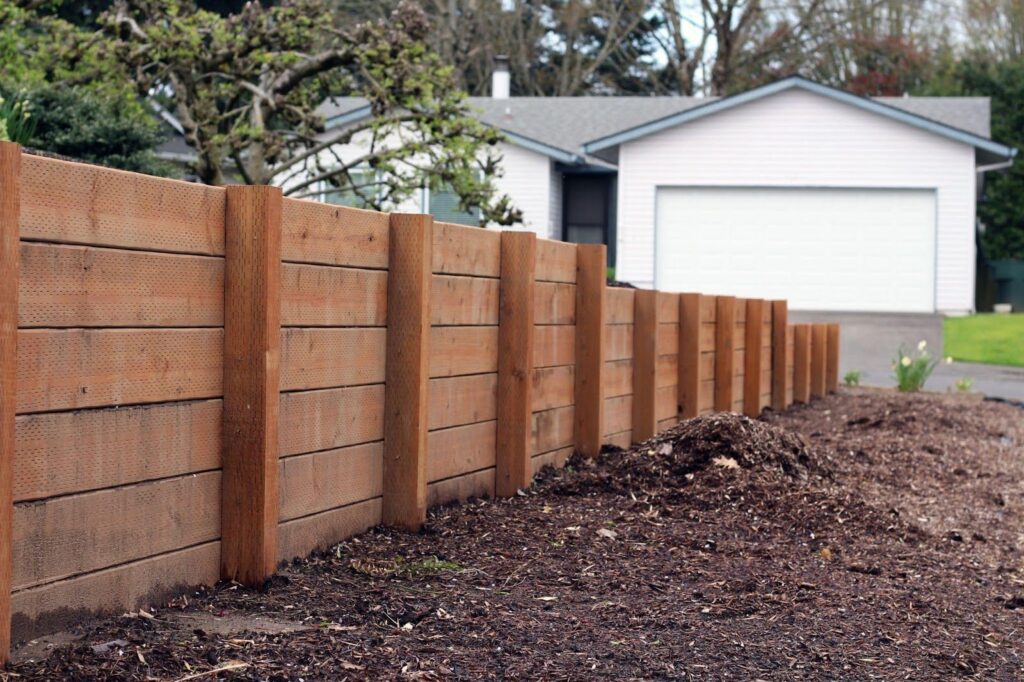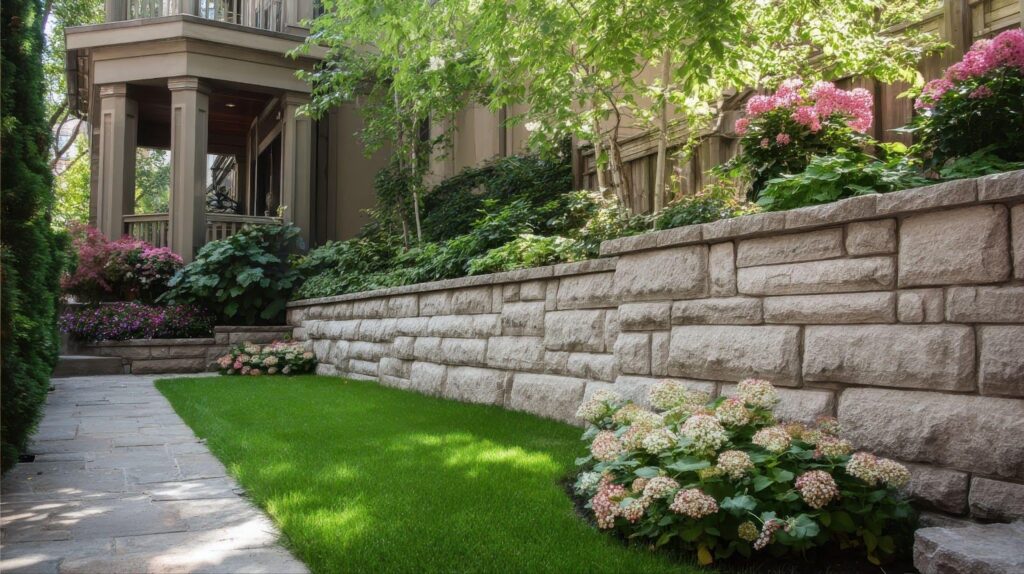Sloped yards present unique landscaping challenges, especially when installing a retaining wall. Rainfall and irrigation often trigger runoff, which strips away topsoil and weakens the integrity of your landscape.
Sloped areas risk erosion, water pooling, and unusable space without proper support. Retaining walls create structural support that holds soil in place while transforming steep terrain into functional, attractive areas.
Installing a retaining wall does more than stabilize your slope. It helps prevent erosion, creates level planting zones or terraces, and adds a striking dimension to your outdoor design. Whether you want to carve out garden beds, define a patio space, or increase curb appeal, the right retaining wall blends utility with beauty.
This blog will guide you through selecting the best retaining wall material for your yard. You’ll explore the pros and cons of popular materials like concrete blocks, natural stone, timber, and more. We’ll also cover important considerations such as slope severity, soil type, and budget to help you make an informed choice that supports long-term landscape health and style.
What to consider before choosing a retaining wall material
Choosing the right retaining wall materials involves more than picking what looks good. To ensure durability, function, and style, you need to assess several critical landscape and environmental factors. Each consideration plays a role in the wall’s longevity, structural integrity, and visual harmony with your outdoor space.
Soil type and drainage
Soil composition directly affects the performance of your retaining wall. Clay-heavy soils retain water and create pressure behind the wall, while sandy or loamy soils allow water to pass through more easily.
Understanding your soil helps determine if you need to install additional drainage solutions, such as weep holes, gravel backfill, or perforated pipes to reduce hydrostatic pressure. Ignoring proper drainage often leads to premature failure, regardless of the wall material’s strength.
Slope grade and wall height
The steeper your slope and the taller the wall, the stronger your material choice needs to be. Low walls for gentle slopes may perform well with timber or dry-stacked stone. Taller walls, especially those supporting steep grades, often require reinforced systems like concrete blocks or poured concrete.
Local building codes may also require engineering approval for walls above a certain height, which can influence material selection and structural planning. To ensure your project meets local requirements and suits your property’s unique conditions, consult with a professional landscaper or contact your local building authority for guidance.
Budget constraints
Every material comes with a different price tag. Natural stone and poured concrete typically cost more due to labor intensity and aesthetic appeal. Timber and segmental retaining wall blocks offer affordable alternatives with easy installation. Before committing to a material, factor in both upfront costs and long-term expenses such as maintenance, repairs, and lifespan.
Maintenance preferences
Some homeowners prefer low-maintenance solutions, while others enjoy regular upkeep. Timber may require sealing or replacement over time, especially in wet climates, while natural stone and concrete blocks resist weathering and need minimal care once properly installed. Choose a material that aligns with how much time and effort you want to invest in maintaining your landscape.
Aesthetic goals and landscape style
Your retaining wall should complement the rest of your yard.
- Natural stone blends beautifully with rustic or traditional landscapes.
- Modern homes often pair well with sleek poured concrete or clean-lined modular block systems.
- Timber suits wooded or casual settings.
Think about texture, color, and form when evaluating how your wall will enhance overall curb appeal.

Local climate and weather conditions
Exposure to freezing temperatures, heavy rainfall, or intense sunlight affects material performance. Timber may warp or decay in wet conditions without treatment. Freeze-thaw cycles may crack unsealed concrete. Select a material built to withstand your regional climate. Durability matters most in areas with extreme temperature swings or frequent storms.
Common retaining wall materials and their pros and cons
When selecting the right material for your retaining wall, weigh the functional requirements of your slope with the overall look and feel you want to achieve. The following materials offer different benefits, challenges, and aesthetic styles to suit a range of landscape needs.
Concrete blocks
Concrete blocks provide a strong, modern solution for sloped yards. Their modular design allows for curved or straight walls, and many come in various textures and colors to enhance visual appeal.
Pros
Concrete blocks deliver long-lasting durability and resist weather damage. Their uniform shape makes them ideal for fast, consistent installation. They work exceptionally well in areas that need structural integrity and minimal upkeep.
Cons
Expect higher upfront costs for both materials and labor. These heavy blocks require a proper base, making installation physically demanding.
Best for
Contemporary landscapes benefit from retaining walls that support tall or load-bearing structures, especially in projects that prioritize low maintenance and long-term strength.
Natural stone
Natural stone adds timeless elegance and seamlessly blends into outdoor settings. Each stone’s unique texture and color variations create a custom look with organic charm.
Pros
This material lasts for decades and elevates landscape design with a high-end appearance. Stone pairs beautifully with gardens, water features, and native plantings.
Cons
Stone walls cost more due to the complexity of fitting irregular shapes. Installing them correctly takes skill and time, which increases labor expenses.
Best for
Rustic, upscale properties with prominent slopes benefit from retaining walls that deliver a strong visual impact and blend naturally into the landscape.
Timber (pressure-treated wood)
Timber walls bring warmth and a natural look to garden spaces. Pressure-treated wood resists insects and moisture for several years, making it a cost-effective option.
Pros
Homeowners appreciate the affordability and ease of working with timber. It allows for quick installation, especially in DIY-friendly projects.
Cons
Wood breaks down over time and often needs replacement within 10 to 15 years. Exposure to moisture increases the risk of rot and warping.
Best for
Short retaining walls, temporary solutions, and budget-conscious projects with a relaxed or woodland aesthetic benefit from timber as a practical and visually fitting material.
Brick
Brick retaining walls deliver classic beauty with rich color and texture. When properly installed with mortar, they offer both form and function.
Pros
Bricks resist fading, support creative patterns, and complement many architectural styles. With a sturdy base, they form a strong, decorative structure.
Cons
Brick walls require a stable footing and expert masonry skills. In colder climates, freeze-thaw cycles may crack the mortar or bricks over time.
Best for
Brick retaining walls enhance character and blend seamlessly with classic architecture, benefiting traditional homes, historic properties, and any setting where timeless detail plays a central role.
Gabion walls
Gabion walls use wire baskets filled with stone, creating a natural-meets-industrial appearance. These structures allow water to pass through easily, making them ideal for erosion control.
Pros
Gabion baskets adjust to ground movement and provide exceptional drainage. Their rugged texture creates a bold visual statement in the landscape.
Cons
The industrial look may not suit all property styles. Untreated wire may rust over time, especially in wet environments.
Best for
Projects that prioritize function and sustainability — such as drainage-heavy slopes or eco-conscious designs with a rustic-modern aesthetic — benefit from gabion walls.
Poured concrete
Poured concrete walls offer unmatched strength and a smooth, minimal design. Once cured, they withstand extreme weather and shifting soil.
Pros
This material performs well in high-stress conditions and lasts for decades with little maintenance. It fits clean, modern designs and supports large-scale retaining needs.
Cons
Poured concrete involves extensive labor and requires formwork before installation. Altering or repairing the structure after pouring proves difficult and expensive.
Best for
Crushed concrete retaining walls benefit minimalist landscapes, commercial properties, and steep slopes that require strong structural support because of their durability and clean appearance.

Build the perfect retaining wall with LaytonScape
LaytonScape brings the expertise and experience needed to help you decide which retaining wall materials work best for your landscaping goals. Our team evaluates your unique landscape challenges and recommends materials that deliver both function and style. From design consultation to installation, we handle every detail with precision and care.
Let us help you transform your sloped yard into a safe, stylish, and usable space. Contact LaytonScape today to get started with a retaining wall that supports your vision and protects your landscape.

